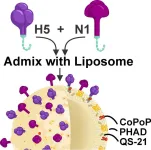(Press-News.org) Research from NASA’s Curiosity rover has found evidence of a carbon cycle on ancient Mars, bringing scientists closer to an answer on whether the Red Planet was ever capable of supporting life.
Lead author Dr. Ben Tutolo, PhD, an associate professor with the Department of Earth, Energy and Environment in the Faculty of Science at the University of Calgary, is a participating scientist on the NASA Mars Science Laboratory Curiosity Rover team.
The team is working to understand climate transitions and habitability on ancient Mars as Curiosity explores Gale Crater.
The paper, published this week in the journal Science, reveals that data from three of Curiosity’s drill sites had siderite, an iron carbonate material, within sulfate-rich layers of Mount Sharp in Gale Crater.
“The discovery of large carbon deposits in Gale Crater represents both a surprising and important breakthrough in our understanding of the geologic and atmospheric evolution of Mars," says Tutolo.
Reaching the strata, he says, was a long-term goal of the Mars Science Laboratory mission.
“The abundance of highly soluble salts in these rocks and similar deposits mapped over much of Mars has been used as evidence of the ‘great drying” of Mars during its dramatic shift from a warm and wet early Mars to its current, cold and dry state,” says Tutolo.
Sedimentary carbonate has long been predicted to have formed under the CO2-rich ancient Martian atmosphere, but Tutolo says identifications had previously been sparse.
NASA’s Curiosity rover landed on Mars on Aug. 5, 2012, and has travelled more than 34 kilometres on the Martian surface.
The discovery of carbonate suggests that the atmosphere contained enough carbon dioxide to support liquid water existing on the planet’s surface. As the atmosphere thinned, the carbon dioxide transformed into rock form.
NASA says future missions and analysis of other sulfate-rich areas on Mars could confirm the findings and help to better understand the planet’s early history and how it transformed as its atmosphere was lost.
Tutolo says scientists are ultimately trying to determine whether Mars was ever capable of supporting life – and the latest paper brings them closer to an answer.
“It tells us that the planet was habitable and that the models for habitability are correct,” he says.
“The broader implications are the planet was habitable up until this time, but then, as the CO2 that had been warming the planet started to precipitate as siderite, it likely impacted Mars’ ability to stay warm.
“The question looking forward is how much of this CO2 from the atmosphere was actually sequestered? Was that potentially a reason we began to lose habitability?”
The latest research, he says, fits with his ongoing work on Earth – trying to turn anthropogenic CO2 into carbonates as a climate change solution.
“Learning about the mechanisms of making these minerals on Mars helps us to better understand how we can do it here,” he says. “Studying the collapse of Mars’ warm and wet early days also tells us that habitability is a very fragile thing.”
Tutolo says it’s clear that small changes in atmospheric CO2 can lead to huge changes in the ability of the planet to harbour life.
“The most remarkable thing about Earth is that it’s habitable and it has been for at least four billion years,” he adds. “Something happened to Mars that didn’t happen to Earth.”
END
Curiosity rover finds large carbon deposits on Mars
UCalgary scientist Ben Tutolo lead author in groundbreaking study published in the journal, Science
2025-04-17
ELSE PRESS RELEASES FROM THIS DATE:
CHOP, Penn Medicine researchers use deep learning algorithm to pinpoint potential disease-causing variants in non-coding regions of the human genome
2025-04-17
Philadelphia, April 17, 2025 – Researchers from Children’s Hospital of Philadelphia (CHOP) and the Perelman School of Medicine at the University of Pennsylvania (Penn Medicine) have successfully employed an algorithm to identify potential mutations which increase disease risk in the noncoding regions our DNA, which make up the vast majority of the human genome. The findings could serve as the basis for detecting disease-associated variants in a range of common diseases. The findings were published online today by the American Journal of Human Genetics.
While certain sections ...
Prevalence of obesity with and without confirmation of excess adiposity among US adults
2025-04-17
About The Study: Among U.S. adults ages 20 to 59, the prevalence of obesity by body mass index (BMI) only was nearly identical with the obesity prevalence after confirmation of excess adiposity. Approximately 98% of individuals identified as having obesity based on BMI had excess adiposity.
Corresponding Author: To contact the corresponding author, Michael Fang, PhD, MHS, email mfang9@jh.edu.
To access the embargoed study: Visit our For The Media website at this link https://media.jamanetwork.com/
(doi:10.1001/jama.2025.2704)
Editor’s Note: Please ...
Population attributable fraction of incident dementia associated with hearing loss
2025-04-17
About The Study: The results of this cohort study suggest that treating hearing loss might delay dementia for a large number of older adults. Public health interventions targeting clinically significant audiometric hearing loss might have broad benefits for dementia prevention. Future research quantifying population attributable fractions should carefully consider which measures are used to define hearing loss, as self-reporting may underestimate hearing-associated dementia risk.
Corresponding Author: To contact the corresponding ...
New study reveals how cleft lip and cleft palate can arise
2025-04-17
CAMBRIDGE, MA -- Cleft lip and cleft palate are among the most common birth defects, occurring in about one in 1,050 births in the United States. These defects, which appear when the tissues that form the lip or the roof of the mouth do not join completely, are believed to be caused by a mix of genetic and environmental factors.
In a new study, MIT biologists have discovered how a genetic variant often found in people with these facial malformations leads to the development of cleft lip and cleft palate.
Their findings suggest that the variant diminishes cells’ supply of transfer RNA, a molecule ...
Scientists hack cell entry to supercharge cancer drugs
2025-04-17
A new discovery could pave the way for more effective cancer treatment by helping certain drugs work better inside the body.
Scientists at Duke University School of Medicine, University of Texas Health Science Center at San Antonio, and University of Arkansas have found a way to improve the uptake of a promising class of cancer-fighting drugs called PROTACs, which have struggled to enter cells due to their large size.
The new method works by taking advantage of a protein called CD36 that helps pull substances into cells. By designing drugs to use this CD36 pathway, researchers delivered 7.7 to 22.3 times more of the drug inside cancer cells, making ...
Study: Experimental bird flu vaccine excels in animal models
2025-04-17
BUFFALO, N.Y. — A vaccine under development at the University at Buffalo has demonstrated complete protection in mice against a deadly variant of the virus that causes bird flu.
The work, detailed in a study published today (April 17) in the journal Cell Biomaterials, focuses on the H5N1 variant known as 2.3.4.4b, which has caused widespread outbreaks in wild birds and poultry, in addition to infecting dairy cattle, domesticated cats, sea lions and other mammals.
In the study, scientists describe a process they’ve developed for creating doses with precise ...
Real-world study finds hydroxyurea effective long-term in children living with sickle cell disease
2025-04-17
(WASHINGTON, April 17, 2024) — Hydroxyurea remains effective long-term in reducing emergency department visits and hospital days for children living with sickle cell disease (SCD), according to new research published in Blood Advances.
“This is one of the first large, real-world, long-term studies to assess the efficacy of hydroxyurea outside of a controlled setting,” said study author Paul George, MD, a pediatric hematology/oncology fellow and PhD candidate at Emory University School of Medicine and Aflac Cancer and Blood Disorders Center at Children’s ...
FAU designated a National Center of Academic Excellence in Cyber Research
2025-04-17
Florida Atlantic University has been recognized as a National Center of Academic Excellence in Cyber Research (CAE-R) by the National Security Agency (NSA) and its partners in the National Centers of Academic Excellence in Cybersecurity (NCAE-C). This prestigious designation, awarded through the academic year 2030, affirms the university’s leadership and innovation in the field of cybersecurity research at the doctoral level.
This recognition places FAU among an elite group of institutions nationwide that have demonstrated a sustained commitment to cutting-edge research in cyber defense and security. The CAE-R designation is awarded to universities whose programs meet rigorous ...
European potato genome decoded: Small gene pool with large differences
2025-04-17
A research team has decoded the genome of historic potato cultivars and used this resource to develop an efficient method for analysis of hundreds of additional potato genomes.
Potatoes are a staple food for over 1.3 billion people. But despite their importance for global food security, breeding successes have been modest. Some of the most popular potato cultivars were bred many decades ago. The reason for this limited success is the complex genome of the potato: there are four copies of the genome in each cell instead of just two. ...
Nontraditional risk factors shed light on unexplained strokes in adults younger than 50
2025-04-17
Research Highlights:
Among adults ages 18-49 (median age of 41 years) who were born with a hole in the upper chambers of their heart known as patent foramen ovale (PFO), strokes of unknown cause were more strongly associated with nontraditional risk factors, such as migraines, liver disease or cancer, rather than more typical factors such as high blood pressure.
Migraine with aura was the top factor linked to strokes of unknown causes, also called cryptogenic strokes, especially among women.
Embargoed ...
LAST 30 PRESS RELEASES:
Making lighter work of calculating fluid and heat flow
Normalizing blood sugar can halve heart attack risk
Lowering blood sugar cuts heart attack risk in people with prediabetes
Study links genetic variants to risk of blinding eye disease in premature infants
Non-opioid ‘pain sponge’ therapy halts cartilage degeneration and relieves chronic pain
AI can pick up cultural values by mimicking how kids learn
China’s ecological redlines offer fast track to 30 x 30 global conservation goal
Invisible indoor threats: emerging household contaminants and their growing risks to human health
Adding antibody treatment to chemo boosts outcomes for children with rare cancer
Germline pathogenic variants among women without a history of breast cancer
Tanning beds triple melanoma risk, potentially causing broad DNA damage
Unique bond identified as key to viral infection speed
Indoor tanning makes youthful skin much older on a genetic level
Mouse model sheds new light on the causes and potential solutions to human GI problems linked to muscular dystrophy
The Journal of Nuclear Medicine ahead-of-print tip sheet: December 12, 2025
Smarter tools for peering into the microscopic world
Applications open for funding to conduct research in the Kinsey Institute archives
Global measure underestimates the severity of food insecurity
Child survivors of critical illness are missing out on timely follow up care
Risk-based vs annual breast cancer screening / the WISDOM randomized clinical trial
University of Toronto launches Electric Vehicle Innovation Ontario to accelerate advanced EV technologies and build Canada’s innovation advantage
Early relapse predicts poor outcomes in aggressive blood cancer
American College of Lifestyle Medicine applauds two CMS models aligned with lifestyle medicine practice and reimbursement
Clinical trial finds cannabis use not a barrier to quitting nicotine vaping
Supplemental nutrition assistance program policies and food insecurity
Switching immune cells to “night mode” could limit damage after a heart attack, study suggests
URI-based Global RIghts Project report spotlights continued troubling trends in worldwide inhumane treatment
Neutrophils are less aggressive at night, explaining why nighttime heart attacks cause less damage than daytime events
Menopausal hormone therapy may not pose breast cancer risk for women with BRCA mutations
Mobile health tool may improve quality of life for adolescent and young adult breast cancer survivors
[Press-News.org] Curiosity rover finds large carbon deposits on MarsUCalgary scientist Ben Tutolo lead author in groundbreaking study published in the journal, Science


